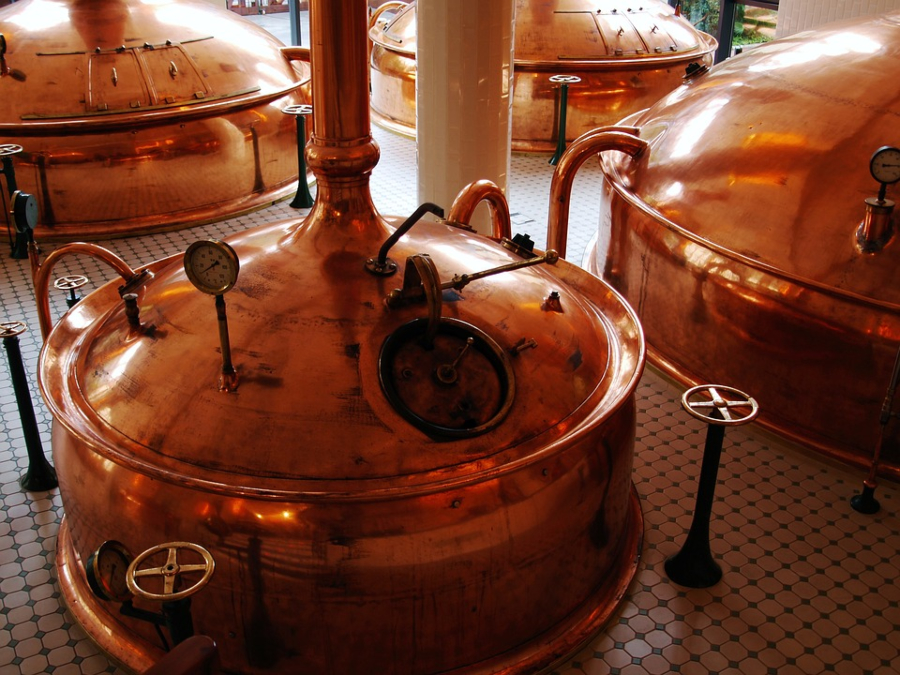11 Questions To Ask To See If Your Brewery Needs A Color-Coding Plan
Written by Adam Serfas

We are often asked whether or not breweries need to implement color-coding in their facilities. To help answer that question we’ve developed this guide meant for breweries large and small.
If you would like to know more about color-coding best practices we invite you to visit our color-coding page. If you're looking to purchase brewery sanitization & color-coding tools visit our brewery sanitization section.
To view this content as a printable pdf click here.
1. Do you use stainless steel tanks?
In a brewery, the most common piece of equipment is usually the tanks. The last thing you want to do is to use a tank cleaning brush that may be too abrasive for the tank surface. A common color-coding practice for tools is to assign color by use. Whereas cleaning floors and counters may require tougher scrub bristles, you want a much softer bristle to clean your tanks – mixing up the two can be a costly mistake as the last thing you would want is a scratched tank.
In this case, you would likely want to incorporate a minimum two-color plan to distinguish the use of each brush type. This is a simple way to implement an extra measure to prevent employees from grabbing the wrong brush - and damaging expensive pieces of equipment.
2. Does your brewery use chemicals?
Many breweries use caustics and acids followed by sanitizers in the cleaning process. It is important that these caustics and acids do not come in contact with the product. Additionally, it is important to prevent these solutions from coming in contact with employees. Color-coding is a great additional measure to ensure that these caustics and acids are separated from sanitizing chemicals and they do not come in contact with employees.
Additionally, many breweries choose to use the chemical quaternary ammonium salt commonly known as “quat” for mold prevention on floors, walls and ceilings. Tools used with the quat sanitizer should never come in contact with any food or beverage. In this case, color coding can be useful to be sure tools used for this specific purpose are easily recognizable and do not cross over to any other parts of the brewery.
3. Do your current tools disintegrate quickly?
This is a common issue for breweries using cheaper tools. Because of the amount of chemicals breweries tend to use, you need tools that are able to withstand chemical interaction. This is economically smart but also important to prevent contamination. Cheap brushes or those made out of materials not suited for coming into contact with chemicals for example, can shed bristles. You certainly wouldn’t want these bristles to find their way into the product. Color-coding can be used to identify certain bristle type to ensure those used in conjunction with chemicals are meant to withstand them.
4. Do you bottle beer?
In any breweries that bottle their product, accidents are bound to happen - which means broken glass. The last thing you would want to happen would be for some of this glass to find its way into the product - or into the tanks which could cause a very expensive scratch. If there isn’t a color-coding plan in place, workers are likely to grab whichever broom or brush is nearby to clean up a mess, you would hope that this brush isn’t later used to clean a tank or a line - but without a color-coding plan you wouldn’t be able to be sure.
In this scenario, having at least two colors for tools in the brewery would be ideal. One color for tools that come in contact with the floor and one color for those that come in contact with the equipment. Additionally, you could dictate a specific color for cleaning up glass shards.
5. Do you currently have limited tools?
Do your employees currently need to travel across the brewery to find the one good push broom, the best brush for scrubbing the floor or search for the couple of paddles that could by lying around anywhere? Not having enough quality tools for your brewery is inefficient. While we aren’t suggesting purchasing superfluous amounts of tools, it is smart to be sure you have all the tools required for each area of your brewery. Color-coding can be used to assign a set of tools for every zone of the facility. That way employees know which tools belong where and have a specific location for returning tools - no more time wasted searching for tools or waiting for another area to be finished using it.
6. Do your tools tend to wander?
Unfortunately, this can be a problem across all production facilities. Tools go missing or are mistreated in facilities all the time. One way to curb this practice is to implement color-coding by zone or shift. When tools have a certain place to be returned to after their use, they are more likely to be treated well and returned. The reasoning behind this is quite simple: employees are being held more accountable. If a tool in a certain zone goes damaged or goes missing, the culpability can be traced to the employees working in that zone. Similarly, color-coding by shift is a common practice - particularly in facilities where there are shifts that may be less managed - such as those with late night shifts.
7. Do you brew both sour and non-sour beers?
If you have a brewery that produces sour and non-sour beers, you should be color-coding tools used for each process. Whereas, modern brewing involves brewing in a very sterile environment meant to prevent the introduction of yeast - sour beer production involves intentionally allowing wild yeast and bacteria into the brew.
Yeast is very aggressive and once it is introduced into a brewing environment, it can be very hard to kill. Color-coding tools that come in contact with yeast-containing brews can help to prevent strains of bacteria and yeast from finding their way from sour beers to other brews.
8. Do you operate a brew pub?
If your brewery houses its own brew pub in the same location, it’s important to keep tools meant for cleaning in the brewery separate than those that are used in the area where beverages and food is served. If these tools are used in the pub and then taken back to the brewery, contaminants that wouldn’t naturally be found in the brewery are introduced - the same goes for the reverse scenario. A color-coding plan by zone would be appropriate to ensure this does not happen.
9. Do you also serve food?
If you serve food, there are several more things to consider when developing a color-coding plan for your culinary and cleaning tools. Things such as allergens should be taken into consideration where you would designate colors for tools to come in contact with those potential allergens and nothing else. Additionally, food service locations that serve meat often assign a certain color of tools to come in contact with raw meat as that poses several additional bacterial contamination risks.
10. Do you have a way to determine traceability in the event of a contamination?
Unfortunately, contamination does happen sometimes in breweries. It’s important that if it does happen you have a way to trace the source. Sometimes the implementation of a color-coding plan can help with this. Say, for example, the contamination was a bristle from a brush. If your brushes were color-coded by brush type, you would know what type of brush lost a bristle. This would allow you to look into whether that type of brush is old and in need of a replacement or simply isn’t compatible with its intended use. If you have color-coded your facility by step in the production process, that bristle color could clue you in on which step of the process the contamination occurred.
11. Do you have a current sanitization plan in place?
If you do not have a current sanitization plan in place, implementing a color-coding plan is a great way to think through the process and identify needs specific to your facility. Additionally, it is a great way to set expectations and accountability standards for employees.
If you already have a current sanitization plan in place, it is likely that it could be improved upon by incorporating color-coding into the procedures already in place. With the proper signage and training, this transition can be a seamless one.


